3 Best Tongue Drums for Beginners (Design & Scale)
There is an ever-growing range of tongue drums on the market and finding the right instrument for a beginner can be a daunting prospect. This article will assist you in shortlisting the best Tongue drums for beginners.
What is the best Tongue Drum for beginners? – A 12 Inch 11 Notes Steel Tongue Drum Percussion instrument with Drum Mallets Carry Bag, 2 Mallets with a textbook is a great starter and comes with all the bits you need. It is best to buy a drum of around 10-12inch in size as it provides more space to home your skills.
Let’s begin by providing a shortlist of alternatives as you begin your Tongue Drum learning journey. Before delving into how to start learning and playing. These instruments offer great quality at an affordable price and are some of the more simplistic variations to help you progress quickly.
List of Tongue Drums for Beginners.
There are a range of tongue drums and more details further down this page, but to get to the meat and those that are featured, this is a quick list of the best tongue drums for beginners, and why
- Yinama – 11 Notes 10 inches [See Price on Amazon] – Customer Satisfaction
- “OcarinaWind” 5.5 inches C Major [See Price on Amazon] – Best for Kids
- KosmoSky Tank Drum W/ Tiki Man – Dive Straight in with one to last for years.
Try to avoid a tongue drum below 9 inches in diameter as a starter instrument.
Larger drums have larger notes to practice your striking accurancy, and have more resonant tones to please your ear as you learn
Steve madgwick – coolpercussion.com
In my experience, if you go in with a cheaper 6 inch drum you are going to find it hard to really nail those notes given the lack of space you will find.
A larger drum with bigger notes will not provide the frustration of a smaller drum, and of course, the larger the size, the bigger and more resonant the notes will sound.
My Favourite Stuff
These are a few of my favorite things including items covered by the subject of this page. All items are personally owned by me, [I have bought them all] and come with the recommendation based on my personal use not just a quick sale affiliate pitch.
Kosmosky Tank Drum
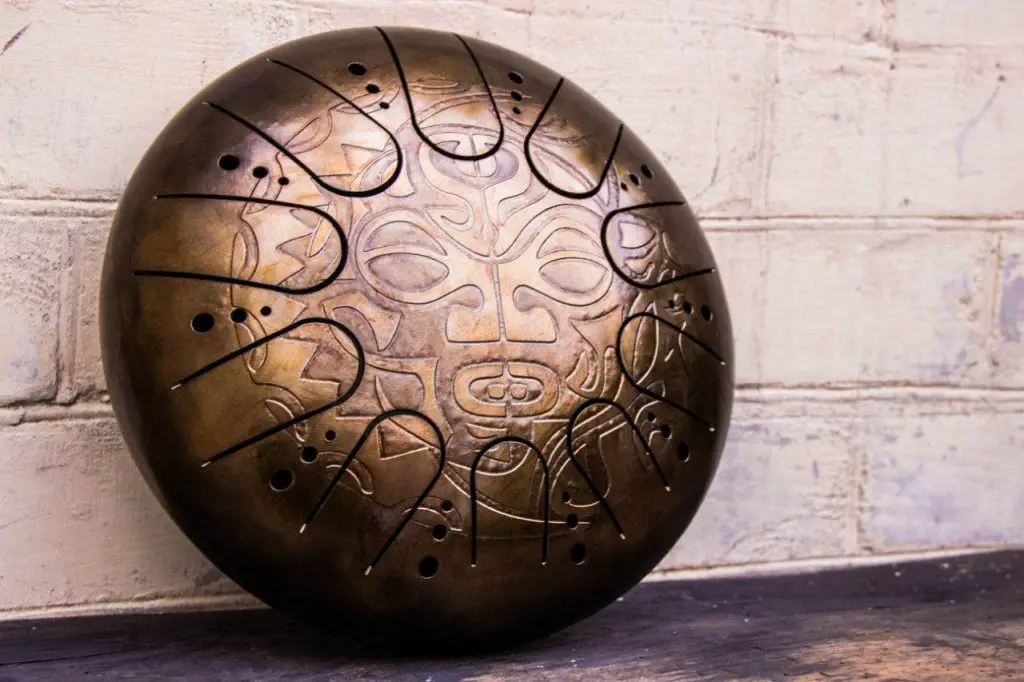
Kosmosky is my favorite tank drum which you can buy direct from the shop.
Priced between $269 to $490 be assured you are buying one of the best Tank drums available in the World saving at least $200 on the Rav Vast
Cheap Tongue Drum Course for Beginners
My good friend Alex has produced this superb video course on how to play Tongue Drum.
Using a Kosmosky tank drum to take you through the basics, there is a follow-up course too when you become more advanced.
The Rav Vast Range
The Rav Vast Tongue Pans are unique in size and sound and start at around $700.
An excellent introductory alternative for people not quite prepared to spend $2000 on a handpan.
Or an upgrade from Tongue drums like Kosmosky
Moozika Kalimba
Kalimbas are awesome and I own about 8 right now, but if you have come across my website looking for Kalimba information, then I will recommend this cheap and easy to buy Kalimba available on Amazon as something to get started on.
In fact it will last you as long as you are learning the instrument.
At around forty bucks, it’s not a bank breaker either.
The Best Tongue Drum Course for Beginners
If you have just purchased a tongue drum or tank drum and can’t wait to get started with playing, a good friend of mine, Alex Connett has a superb tank drum for beginners video course available at a super cheap price of $35.
Best Tongue Drums for Beginners
Here is some more detail on the three tongue drums I recommend. two for adults and the best tongue drum for kids.
BUDGET – Yinama – 11 Notes 10 inches
With this instrument, you have a larger diameter of 12 inches (with an option of a smaller 10 inch version).
It remains portable and the size also makes it easy to learn on with 11 notes ensuring you do not get bored quickly.
Fewer notes can hold back your learning, the 11 note range means you can go on progressing beyond learner level and it will still be good for more advanced learning prior to upgrading to a more expensive tank drum if you are on a budget.

Take a look at the full package on Amazon
What I like about this choice for beginners is that it comes in a full package with
- Mallets
- Music Book
- Note Stickers
- Bag
BEST – KosmoSky Tank Drum With Tiki Man Engrave
Make no mistake, this tank drum from KosmoSky will provide you with the clearest most beautiful sounding tones on a steel tank drum that will last a lifetime.
You’ll be looking to spend from $269 upwards for one of these drums, but if you are serious about learning and playing tank drums, then this will be the only one you’ll ever need.
That is, until you want to experiment with other scales and styles. But for an investment into your learning, you’ll do no better with one of the best value tongue drum instruments available.
FOR KIDS – “OcarinaWind” 5.5 inches C Major
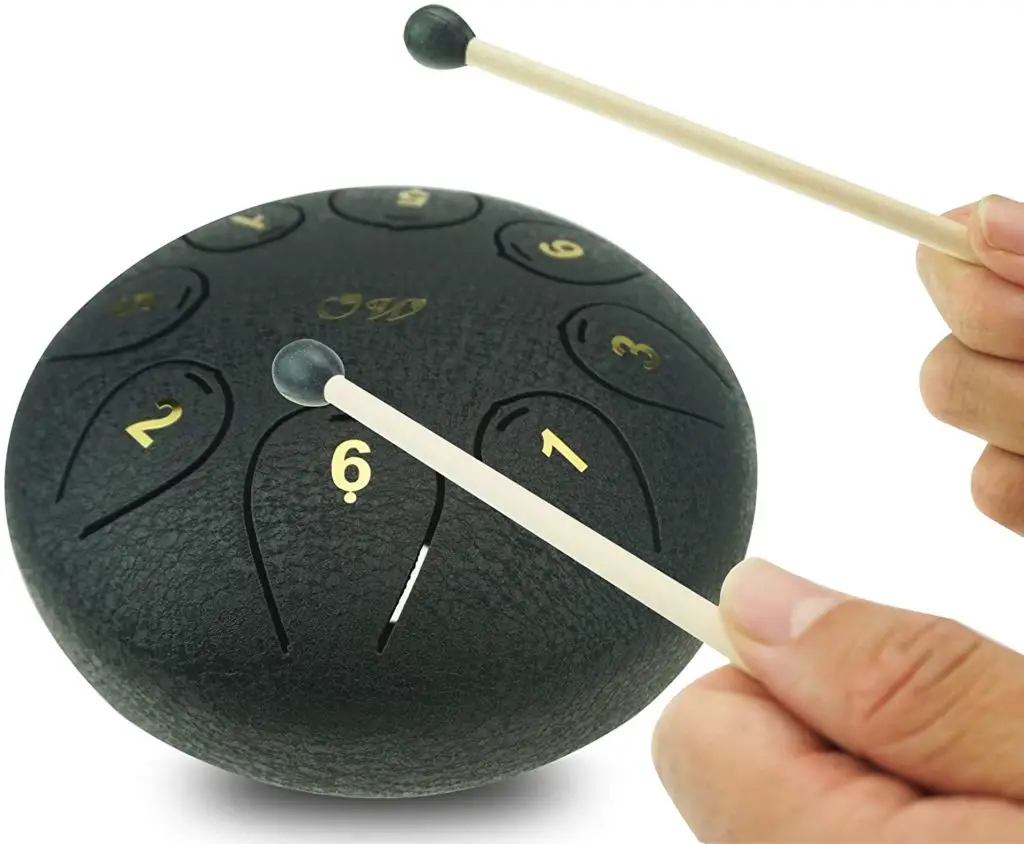
The smallest of the tongue drums recommended on this page, the OcarinaWind be the budget choice and a good instrument for kids.
As mentioned for adults, this might be a bit small and prohibitive for learning, however…
I especially like this one for children as an alternative to the multicolored metal xylophone/glockenspiels that you always see. I feel this tongue drum is a really good introduction to percussion instruments.
8 tongues on this drum, tuned to my favorite scale of C Major, provide a super-portable instrument you can take anywhere with you, in the bag supplied in the package.
Check availability and price on Amazon
How to Choose My First Tongue Drum
How you have come about the tongue drum instrument may be different from me. I learned about them, having gained an interest in handpans, and with the discovery of the RAV Vast.
A larger type of tongue drum, not dissimilar to a handpan. The Rav may not be the best tongue drum for beginners though. It is the largest type, and the tongues are cut in such a way as to present more options for playing.
This guide will comprise of looking at more simple tongue drums suited to those considering purchasing and playing for the first time.
Size
Tongue drums are available in a range of sizes. The smallest can be very small, although for ease of use I wouldn’t suggest anything smaller than 6 to 7 inches. As a beginner, your accuracy in striking the notes would have to be quite acute on the smallest of choices.
Small Tongue Drums [Approx 22cm/8inches]
- Around 2kg
- Portable
- Cheaper
- Good for Kids
- Usually only one-sided [Single scale]
- Limited Number of Notes
- Smaller Tone Fields
Medium Tongue Drums [30m/12 inches]
- Around 4kg
- Less Portable but still OK
- Mid-range prices
- Suitable for music students
- More space can mean more notes
- Can be double-sided with different scales
- Accuracy important but larger tongues can help
Large Tongue Drums [35cm+/14 inches+]
- In excess of 5kg
- Great for home meditation and play
- Good for get-togethers and jamming
- Can be more expensive
- Largest drums will have bigger tones fields and versatility
- Can be double-sided with different scales.
Smaller tongue drums do have the advantage of portability. You can transport a small tank drum quite easily and take it with you wherever you go.
If traveling by air, it will fit snugly into your rucksack, as well as having the advantage of being much lighter than larger versions. Even a mid-sized tongue drum could fit in your hand luggage comfortably, but you do have to consider the extra weight at around 4kg.
With most aircraft carriers allowing only 10kgs in hand-luggage and others just 7kg, you would be taking up over half of your total allowance.
Which Airline Allows the Most hand Luggage? – Find out here
Over 100 different Airline hand luggage weights and dimensions
Apart from portability and being able to take your drum with you wherever you go, arguably the most important aspect in size consideration is SOUND.
The difference in size will also affect the depth of sound achievable from each. Although, some of the smaller drums will surprise you with the volume they can produce.
Scale
The next thing to consider is the scale of the instrument you would like. There are no recommendations for this as it will be very much down to the scale that you prefer to listen to.
The advice here is, if you don’t already know what scale you like, go listen to some and see which resonates with you best. Which gives you the feeling you want to achieve from your instrument.
As a general guide, happy, cheerful or joyous scales will be Major scales, while darker, more thoughtful or serious scales will be Minor Scales.
This image is an old fashioned guide, but pretty accurate at the same time.

To hear how they differ, it is only slight but definitely noticeable from a mood perspective, is to listen to as many as you can.
The video below is a great example of how Major and Minor scales differ. A couple of notes on the video.
The tongue drums used are Rav Vast, a superior instrument that may not be the first drum you will want to buy, given you would be looking to invest in the region of $1000 for one. Each of them are in the Key of B. Take a listen
Design
Now we begin to get into real personal preferences. The design is not going to be a major consideration in terms of how it affects performance, but more of just how the tongue drum looks.
That said, as you can see below, there are many different ways the tongues are cut. This adds to the look of the instrument, but in each case, they are cut a specific way to suit the instrument and achieve the required notes. Sometimes with the aid of magnets.
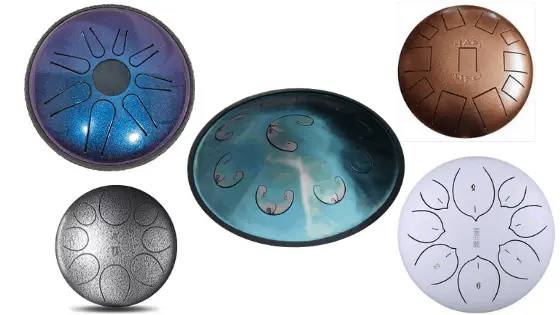
The tongue drum in the center, you will note, looks quite different from the others. This tongue drum is a RAV VAST and has more of a handpan look about it, rather than a tongue drum. It is more in the handpan class than the ‘tank drum’ class of instruments, born from the inspiration of instruments made from propane gas tanks [Hence the original name]. For more information, see my tongue drum history article, where I explain the origins
Designs will be a consideration of types, sizes and tongue shapes. You will also note a beautiful design of GUDA tongue drum on my recommended tongue drums page. In my opinion, it is the best looking tongue drum on the market.

Both the RAV Vast and the GUDA Freezbee are not recommended for beginners. I would recommend spending a little less money to get started and upgrade if you feel it is something you would like to progress with, as they cost a great deal more
Color
You may have noticed already that tongue drums can be available in a range of colors.
As with the design above, as a beginner, you should really concentrate on choosing a scale and key before concerning yourself with the color of your new tongue drum.
Once you have chosen the tongue drum type you want, and the key and scale, then and only then, if there is an option of colors to choose from, make it a consideration.
Whilst they can be decorative, the main purpose of your tongue drum is that you are a beginner and you want something practical and useable to learn on.
Accessories?
Tongue Drum accessories can come as part of the package with purchases and can include
- Mallets
- Storage and transportation cases
- Playing guides
- Note stickers
Mallets
Mallets are the preferred way of playing the tongue drum or tank drum. Sometimes, the mallets provided in a package will be quite hard plastic, which is not bad, but if you can find and purchase some slightly softer mallets, you might get a less hard sound and prefer the results.
You can even experiment with a range of mallets until you get the sound and resonance that you like the best.
Cases
Storage and carry cases are great to protect your instrument when not playing or on the move. It is not recommended to leave your tongue drum stored in a bag for an extreme length of time, and it is always worth having a moisture eater bag inside, just to remove excess moisture.
Beginners Book
The playing guides that come with some tongue drums are OK. They cover the very basics but do not expect to learn a huge amount from them.
Note Stickers
Generally, these will come in the form of a set of stickers numbered 1 up to the total number of notes you have on your tongue drum. Numbering 1 for the lowest note, and upward through the scale.
These are not essential, but complete beginners might want to utilize them just to identify the notes, to begin with. Often these stickers come with the playing guide in a package and will relate to some simple tunes to get you started with playing your tongue drum for the first time.
Single or double-sided?
Another option for tongue drums which makes them quite unique is that you can have a different set of notes and scales on both the top and the bottom sides.
This is not something I would advise against, as it is an excellent way of being able to learn more than one scale and way to play the tongue drum. You can experiment, practice and produce two very different sounds if your instrument is set up this way
Expect to be paying much more for a two-sided tongue drum.
How many notes are ideal when a beginner?
When learning to play the tongue drum as a beginner, I would suggest looking for an instrument with between 8-10 notes.
It is possible to get tongue drums with many more notes on the top. If you have no basic musical theory knowledge, it is best to take things slowly, however, if you do have an understanding of scales, progression and more from the basics, then, yeah, why not, go for a 14 note example
As a beginner, should I play with hands or mallets?
You will find it harder to play and find a technique on a tongue drum with fingers and hands, to begin with. The advice is, to begin with, the mallets supplied. These mallets may not be the best it has to be said, but see how you get on with them, and if you need to replace them with some inexpensive softer plastic tongue drum mallets from amazon.
By all means, practice with your hands, you may, in time, come to prefer the ‘feel’ you get playing this way.
You will find the with the smaller tongue drums, mallets are the best way to play given the limited space of the note on the drum. Combining strength and accuracy well on the smaller ones can be tricky, whereas, as you may have seen in the video above when playing the largest of instruments, the fingers and hands work well
How much should I spend my first tongue drum?
How much you spend on your first tongue drum may be dictated by a number of factors including, your own budget of course, but also if you are buying this type of instrument for the first time. It may be for a child, or for a meditative group or just for personal hobby playing.
To an extent the age-old rule of you get what you pay for will apply, but you should not get a bad instrument if spending around $100 upwards.
There are some cheaper, smaller instruments on the market. For children or for fun, they are OK. Anything below $50 is going to fall into this range. But there is nothing wrong with buying a cheaper instrument to begin with, just don’t expect to be able to reproduce some of the sounds you may have heard when researching YouTube videos. These will in most cases be better quality instruments being showcased.
Tongue Drum Lessons
It is possible to get some lessons for learning to play the tongue drum for beginners. There are a number of ways you can do this. You can watch some YouTube videos as a starting point, or make a small investment in a dedicated tongue drum playing course from Master The Handpan.
If looking to go down the video course route, I would highly recommend this essentials beginners course. it is quite inexpensive, but contains dozens of easy to follow video lessons, which you can watch and practice with. marking off each as you complete it, but being able to go back, revisit and master each as you progress.
For more information take a look at the Learn to play tongue drum page, where I go into more detail into the starting point, what to concentrate on, and advise on how to progress into a great tongue drum player, for whatever use you are putting yours to.



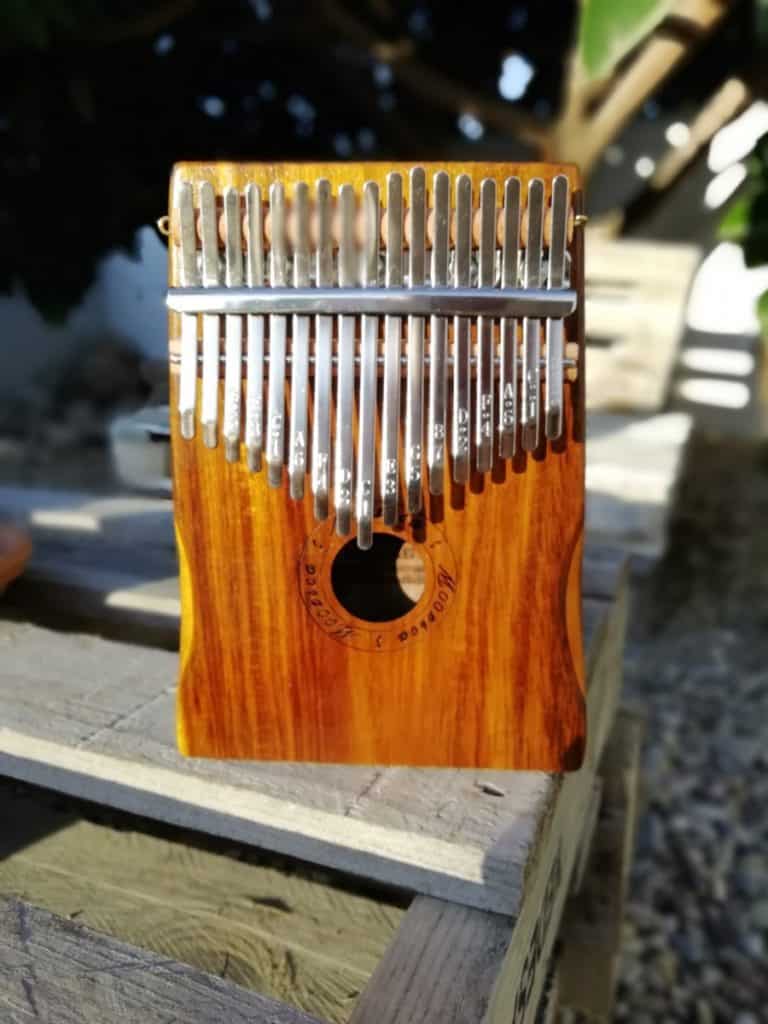
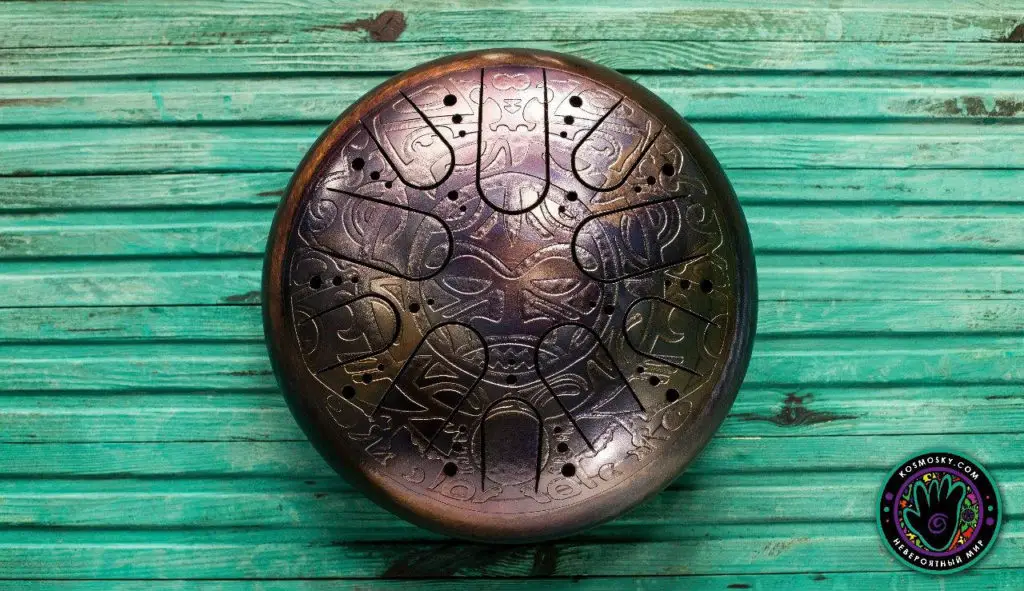
![Hang Drum for Sale | Handpan & Tongue Drum Buying Guide [New]](https://cdn-0.coolpercussion.com/wp-content/uploads/2019/11/Hang-drum-for-Sale-768x384.png)



